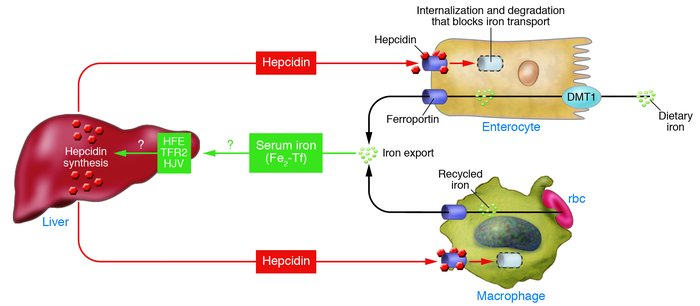Sophie Vaulont, … , Lydie Viatte, Axel Kahn
Citation Information: J Clin Invest. 2005;115(8):2079-2082. https://doi.org/10.1172/JCI25642.
Sophie Vaulont, … , Lydie Viatte, Axel Kahn
Published August 1, 2005
Citation Information: J Clin Invest. 2005;115(8):2079-2082. https://doi.org/10.1172/JCI25642.
Abstract
Recently, mutations causing juvenile hemochromatosis have been identified in a novel gene, hemojuvelin (HJV), located on chromosome 1. Mouse models of this disease have now been developed by 2 groups, Huang et al. and Niederkofler et al., through targeted disruption of the Hjv gene (see the related articles beginning on pages 2180 and 2187). These mutant mice will allow further investigation into the role of HJV in the regulation of iron homeostasis, a role that to date remains elusive.
Authors
Sophie Vaulont, Dan-Qing Lou, Lydie Viatte, Axel Kahn
Figure 1
Options:
View larger image
(or click on image)
Download as PowerPoint
Regulation of systemic iron homeostasis. Increased diferric transferrin, Fe2-Tf, is detected by the liver via an as-yet unknown complex regulatory pathway involving HFE, TFR2, and HJV. Hepatocytes respond to this signal by inducing HAMP expression and hepcidin secretion. Circulating hepcidin acts in turn to diminish dietary iron absorption by the enterocytes and iron recycling by the macrophages through the internalization of ferroportin, which blocks iron export. As a consequence, serum iron decreases. As a feedback response, hepcidin synthesis is downregulated, which allows ferroportin molecules to be displayed on the surface of the target cells. In classical and juvenile hemochromatosis the mutations in HFE , TFR2 , and HJV lead to abnormal hepcidin regulation, hypohepcidinemia, and ferroportin hyperactivity. The latter results in increased iron absorption and uncontrolled iron release from macrophages, 2 defects characteristic of hereditary hemochromatosis. DMT1, divalent metal transporter 1.



Copyright © 2025 American Society for Clinical Investigation
ISSN: 0021-9738 (print), 1558-8238 (online)

